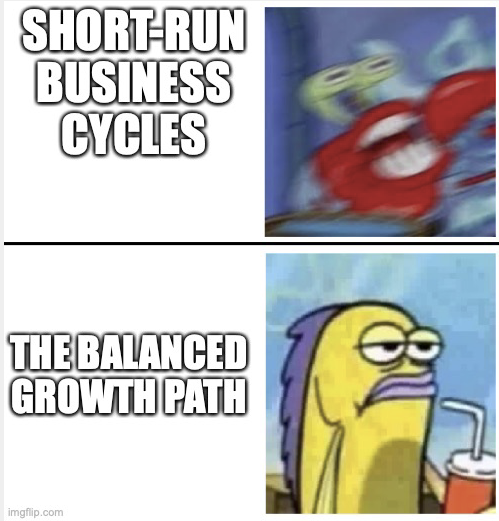Balanced growth path

This last section is not about a new fact, but rather about a term - “balanced growth path” - that is a description of the set of facts just reviewed. A balanced growth path, often abbreviated BGP, is defined by a series of facts that roughly approximate the observed data in developed countries like the US. You can actually find several different definitions of what a BGP is. For the purposes of this study guide, this is the set of facts we’ll use to define a BGP.
A country is said to have a balanced growth path (BGP) if the following four conditions hold:
- The growth rate of GDP per capita ($g_y$) is stable
- The ratio of gross capital formation to GDP ($I/Y$) is stable
- Labor’s share of costs ($\phi_L$) is stable
- The capital/output ratio ($K/Y$) is stable
The US, for example, has data that conforms to these four facts. Because of that, we will say that the US is “on a balanced growth path”. A number of other countries we looked at (Canada, Australia, the UK, Mexico) all appear to be on a balanced growth path as well. A number of other countries (South Korea, Germany, Japan) did not seem to be “on” a BGP for a long time, but they all seemed to have reached a BGP by around the year 2000. For countries like China and Nigeria, they do not appear to be “on” a BGP, and it remains an open question of whether they will end up on a BGP.
The definition of a BGP is helpful because it allows us to focus on some key regularities in the data. When we try to model the economy and how it grows, we’re going to want that model to replicate the outcomes associated with a BGP, because we see so many countries with those characteristics. In addition, we’ll want that model to help explain why countries that are “off” a BGP at some point (like South Korea, Germany, or Japan) all end up back “on” a BGP after some period of time. Finally, once we have that model, we’ll use it to predict what might happen to places like Nigeria and China.
A BGP defines a hypothetical economy that our model will match. We can draw figures similar to those we saw using actual data, but now for this hypothetical BGP economy. They are not very exciting. In my defense, these figures were how I taught myself to use Plotly to embed figures on this site, so I’m just happy that they all work.